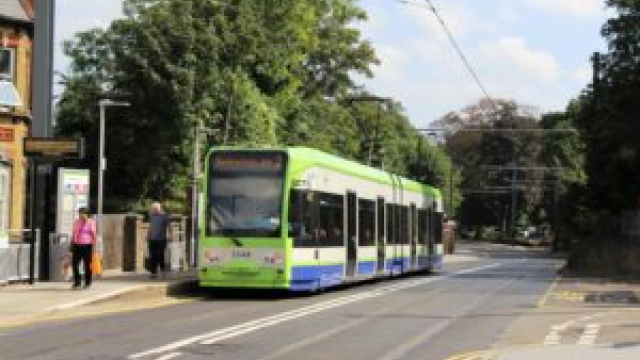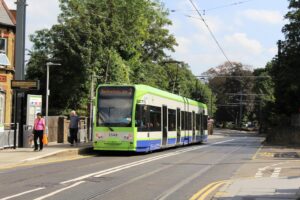Above: Street Running Tramlink, at Tram Stop No. 7, Lebanon Road
Tramlink and New Addington: Light Rail as a Catalyst for Social and Economic Regeneration in Croydon
(Note: this article is an AI-generated article summarising email exchanges, composed of a discussion between anonimysed experts involved with the planning and building of the line copied here: https://claverton-energy.com/how-trams-in-croydon-tramlink-improved-the-economy-and-sink-estates.html )
Introduction
Croydon Tramlink, opened in 2000, is a well-established example of how light rail investment can support economic regeneration, tackle social exclusion, and provide equitable public transport access in a dense urban context. As with several other UK tram systems—including Manchester Metrolink, Nottingham Express Transit (NET), and Sheffield Supertram—Tramlink was designed with regeneration as a core objective, particularly to serve deprived public housing estates such as New Addington.
The Context: New Addington and Social Deprivation
New Addington, located in the London Borough of Croydon, was developed post-World War II as a large public housing estate. By the 1980s and 1990s, it had become one of the most deprived areas in London, with limited public transport access, poor job connectivity, and a growing sense of isolation [6]. Public transport consisted mainly of infrequent and unreliable buses, and peak-hour journeys to employment centres in Croydon and beyond were long and unpredictable.
Rationale for Tramlink Construction
The isolation of New Addington became a key driver behind the inclusion of the area in the initial Tramlink alignment. As early as the 1960s, proposals emerged to connect the estate via light rail or other rapid transit systems. Following the publication of “Light Rail for London” by LT Planning in 1987, the project advanced through development stages and received political backing to include New Addington as one terminus of the new network.
Construction began in the late 1990s and the line opened in May 2000. Key stakeholders included Transport for London (TfL), Croydon Council, and transport professionals such as BD (BD = A senior official involved) and Dave Cockle.
Documented Impacts of Tramlink
A 2002 study by TfL—the Tramlink Impact Study—highlighted several significant regeneration outcomes [4]:
- A measurable increase in employment access for New Addington residents, particularly those accessing jobs along the A23/Purley Way corridor.
- A reduction in the number of seriously deprived families in New Addington.
- Improved access to central Croydon and Wimbledon, including from the similarly deprived Phipps Bridge estate.
- Improved access for mobility-impaired and socially excluded groups.
Academic research supports these findings. Knowles (2004) notes that Tramlink “provided a step-change in orbital connectivity” and supported Croydon’s retail and commercial development [5].
A paper by Siraut (2004) for WIT Press found that Tramlink assisted in attracting high-profile investors, increasing property values modestly, and supporting job creation and recruitment [9].
Comparative Success in UK Light Rail
Croydon is not unique. Multiple UK tram systems have demonstrated similar benefits:
- Manchester Metrolink: Credited with regenerating Oldham and Rochdale; brought brownfield sites into use and improved employment access [3].
- Nottingham NET: Improved access for deprived areas such as Hyson Green; integrated ticketing and investment in public realm helped support small businesses [7].
- Edinburgh Trams: Despite a difficult construction period, the line now exceeds ridership forecasts and has catalysed redevelopment in Leith [1].
Time Lag and Policy Support
As urbanist David Walmsley noted, the impact of rapid transit systems often takes a decade or more to manifest fully. Urban development, population shifts, and business growth lag behind infrastructure investment, which makes longitudinal study critical [10].
Moreover, CG notes that successful outcomes depend not only on the infrastructure but also on policy—especially land-use planning, housing provision, and complementary transport integration.
Conclusion
Croydon Tramlink, alongside Manchester, Nottingham, and others, is a demonstrable success in using light rail to support economic and social regeneration. In New Addington, it improved access, reduced social exclusion, and helped reconnect a marginalised community to the wider urban economy. With appropriate planning and policy frameworks, similar outcomes can be achieved in other cities.
References
[1] Transport for London (2011). Crossrail Property Impact Study – Impacts on Office and Retail Markets. https://content.tfl.gov.uk/property-impacts-report-acc.pdf
[2] Transport for London (2022). Crossrail Evaluation: Case Study Report – Wider Economic Impacts. https://content.tfl.gov.uk/case-study-report-acc.pdf
[3] Urban Transport Group (2018). What Light Rail Can Do for Cities. https://www.urbantransportgroup.org/system/files/general-docs/WhatLightRailCanDoforCitiesMainText_0218.pdf
[4] Transport for London (2002). Tramlink Impact Study Summary Report. https://foi.tfl.gov.uk/FOI-1142-1819/Croydon%20Tramlink%20Impact%20Study%20summary%20report%202002.pdf
[5] Knowles, R.D. (2004). Transport impacts of the Croydon Tramlink. Journal of Transport Geography, 12(4), 275–287. https://doi.org/10.1016/j.jtrangeo.2004.08.002
[6] Power, A. (1997). Estates on the Edge: The Social Consequences of Mass Housing in Northern Europe. Palgrave Macmillan.
[7] House of Commons Transport Committee (2005). Integrated Transport: Written Evidence on Croydon Tramlink. https://publications.parliament.uk/pa/cm200405/cmselect/cmtran/378/378we36.htm
[8] Gleave, S.D. / Urban Transport Group (2005). What Light Rail Can Do for Cities. https://www.reconnectingamerica.org/assets/Uploads/bestpractice201.pdf
[9] Siraut, J. (2004). Economic and regeneration impacts of Croydon Tramlink. In: Urban Transport X, WIT Press, pp. 865–874. https://www.witpress.com/Secure/elibrary/papers/UT04/UT04085FU.pdf
[10] Walmsley, D.A. & Perrett, K.E. (1992). The Effects of Rapid Transit on Public Transport and Urban Development. TRL Research Report 278.



